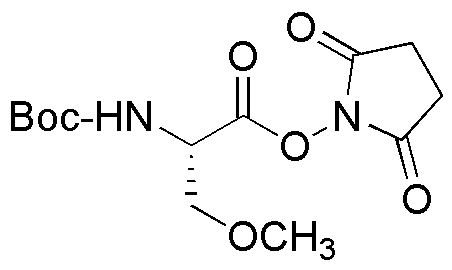Boc-O-methyl-L-serine N-hydroxysuccinamide ester is widely utilized in research focused on:
- Peptide Synthesis: This compound serves as a valuable building block in the synthesis of peptides, allowing researchers to create specific sequences with enhanced stability and functionality.
- Drug Development: Its unique structure makes it useful in designing prodrugs, which can improve the bioavailability of therapeutic agents by enhancing their solubility and absorption in the body.
- Bioconjugation: The compound is employed in bioconjugation processes, facilitating the attachment of biomolecules to surfaces or other molecules, which is essential in developing targeted drug delivery systems.
- Protein Modification: Researchers utilize this ester for modifying proteins, enabling the study of protein interactions and functions, which is crucial in understanding disease mechanisms.
- Diagnostics: Its properties allow for the development of diagnostic tools, such as assays that can detect specific biomolecules, aiding in early disease detection and monitoring.
General Information
Properties
Safety and Regulations
Applications
Boc-O-methyl-L-serine N-hydroxysuccinamide ester is widely utilized in research focused on:
- Peptide Synthesis: This compound serves as a valuable building block in the synthesis of peptides, allowing researchers to create specific sequences with enhanced stability and functionality.
- Drug Development: Its unique structure makes it useful in designing prodrugs, which can improve the bioavailability of therapeutic agents by enhancing their solubility and absorption in the body.
- Bioconjugation: The compound is employed in bioconjugation processes, facilitating the attachment of biomolecules to surfaces or other molecules, which is essential in developing targeted drug delivery systems.
- Protein Modification: Researchers utilize this ester for modifying proteins, enabling the study of protein interactions and functions, which is crucial in understanding disease mechanisms.
- Diagnostics: Its properties allow for the development of diagnostic tools, such as assays that can detect specific biomolecules, aiding in early disease detection and monitoring.
Documents
Safety Data Sheets (SDS)
The SDS provides comprehensive safety information on handling, storage, and disposal of the product.
Product Specification (PS)
The PS provides a comprehensive breakdown of the product’s properties, including chemical composition, physical state, purity, and storage requirements. It also details acceptable quality ranges and the product's intended applications.
Certificates of Analysis (COA)
Search for Certificates of Analysis (COA) by entering the products Lot Number. Lot and Batch Numbers can be found on a product’s label following the words ‘Lot’ or ‘Batch’.
Número de catálogo
Número de lote/lote
Certificates Of Origin (COO)
This COO confirms the country where the product was manufactured, and also details the materials and components used in it and whether it is derived from natural, synthetic, or other specific sources. This certificate may be required for customs, trade, and regulatory compliance.
Número de catálogo
Número de lote/lote
Safety Data Sheets (SDS)
The SDS provides comprehensive safety information on handling, storage, and disposal of the product.
DownloadProduct Specification (PS)
The PS provides a comprehensive breakdown of the product’s properties, including chemical composition, physical state, purity, and storage requirements. It also details acceptable quality ranges and the product's intended applications.
DownloadCertificates of Analysis (COA)
Search for Certificates of Analysis (COA) by entering the products Lot Number. Lot and Batch Numbers can be found on a product’s label following the words ‘Lot’ or ‘Batch’.
Número de catálogo
Número de lote/lote
Certificates Of Origin (COO)
This COO confirms the country where the product was manufactured, and also details the materials and components used in it and whether it is derived from natural, synthetic, or other specific sources. This certificate may be required for customs, trade, and regulatory compliance.


